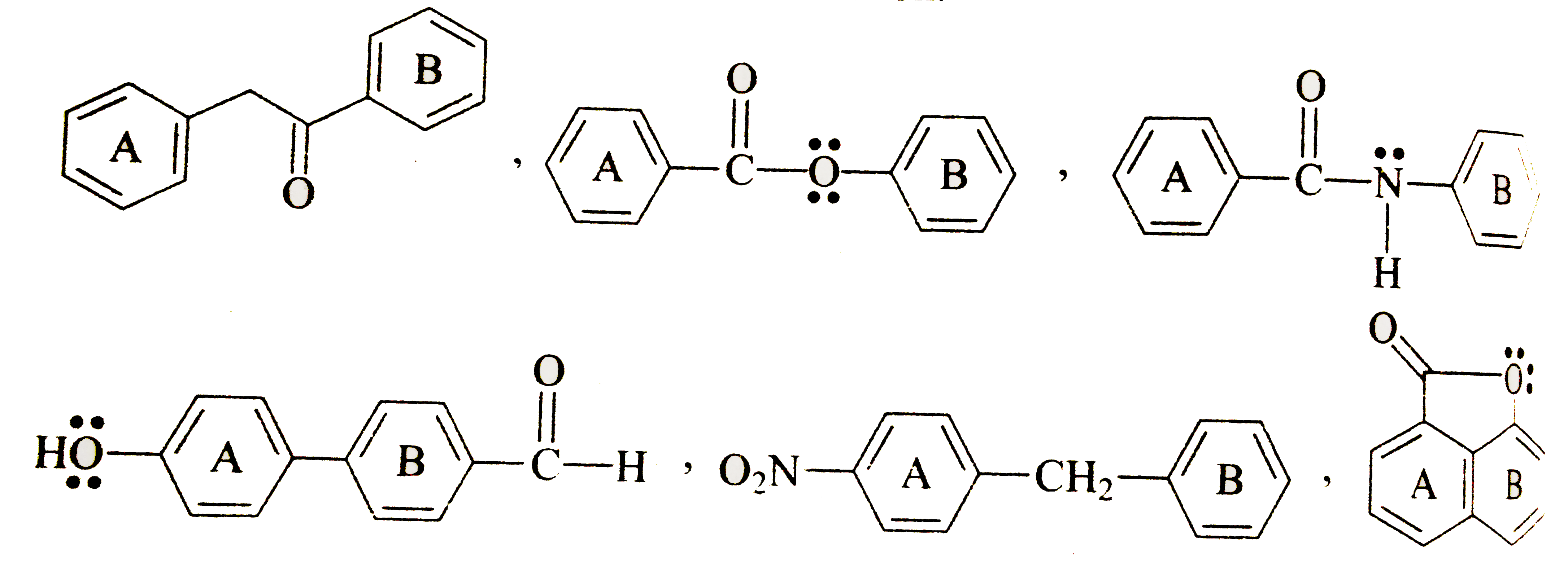Each of the six compounds shown at the bottom of the page has two aromatic (benzene) rings. In each case the two rings are different and are labeled A & B. If an electrophilic substitution, such as nitration or bromination, is carried out on each compound, then identify which ring (A or B) will be preferntially attacked, and indicate the orientation of the substitution (orhto/para, meta or all sites)
CompoundReactivitySubstitutionCompoundReactivitySubstitution1Aortho/para2Aortho/paraBmetaBmetaall sitesall sites3Aortho/para4Aortho/paraBmetaBmetaall sitesall sites5Aortho/para6Aortho/paraBmetaBmetaall sitesall sites

The correct Answer is:(##MSCORGCHMC12E01218_A01##)
Electrophilic Aromatic Substitution
Each of the six compounds shown at the bottom of the page has two aromatic (benzene) rings. In every case the two rings are different and are labled A and B. If an electrophilic substitution, such as nitration or bromination, is carried out on each compound can the major product (s) be predicted ? Identify which ring (A or B) will be preferentially attacked, and indicate the orientation of the substitution (ortho/para, meta or all sites).

Topper's Solved these Questions
- AROMATIC COMPOUNDSBOOK - MS CHOUHANCHAPTER - AROMATIC COMPOUNDSEXERCISE - Subjective Problems
3 Videos
- AROMATIC COMPOUNDSBOOK - MS CHOUHANCHAPTER - AROMATIC COMPOUNDSEXERCISE - Solved Problem
48 Videos
- AROMATIC COMPOUNDSBOOK - MS CHOUHANCHAPTER - AROMATIC COMPOUNDSEXERCISE - Level 1 (Q.181 To Q.210)
1 Videos
- AN INTRODUCTION TO ORGANIC REACTIONS AND THEIR MECHANISMS ACIDS AND BASESBOOK - MS CHOUHANCHAPTER - AN INTRODUCTION TO ORGANIC REACTIONS AND THEIR MECHANISMS ACIDS AND BASESEXERCISE - ADDITIONAL QUESTION (SINGLE CORRECT CHOICE TYPE )
32 Videos
- BIOMOLECULESBOOK - MS CHOUHANCHAPTER - BIOMOLECULESEXERCISE - Level 2
1 Videos
Similar Questions
Each of the compounds shows below has two aromatic ring. Labled as A and Identify number of compounds in which ring B is more active than ring A for electrophilic aromatic substitution reaction .


View SolutionThe most deactivating group for electrophilic substitution reaction in benzene ring is
View Solution
Knowledge Check
Which of the following reactions is not an example of electrophilic substitution in benzene ring?
A B
B C
C D
D
Which of the following reactions is not an example of electrophilic substitution in benzene ring?
A B
B C
C D
D
Which of the following substituents deactivates the benzene ring towards electrophilic substitution?
A−CHOB−NR2C−NHCOCH3D−NO2
The most deactivating group for electrophilic substitution reaction in benzene ring is
View SolutionFor an electrophilic substitution reaction , the presence of a halogen atom in the benzene ring …..
View SolutionWhich of the following group activates the benzene ring most towards electrophilic substitution
View SolutionWhich of the following froups groups deactivates the benzene ring towards electrophilic substitution ?
View SolutionWhich of the following substituents deactivates the benzene ring towards electrophilic substitution?
View Solution
